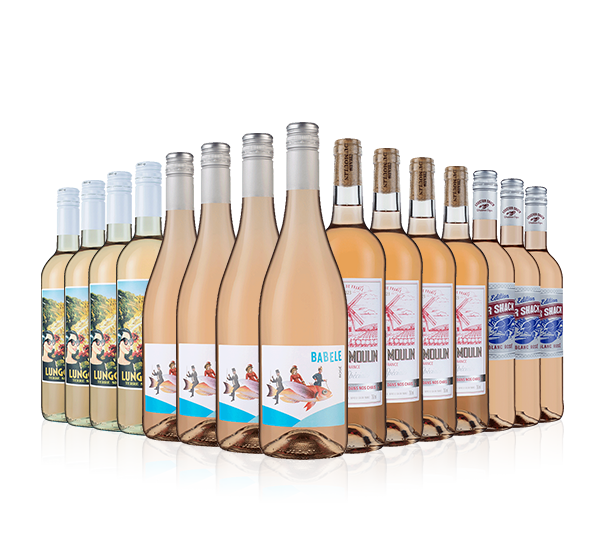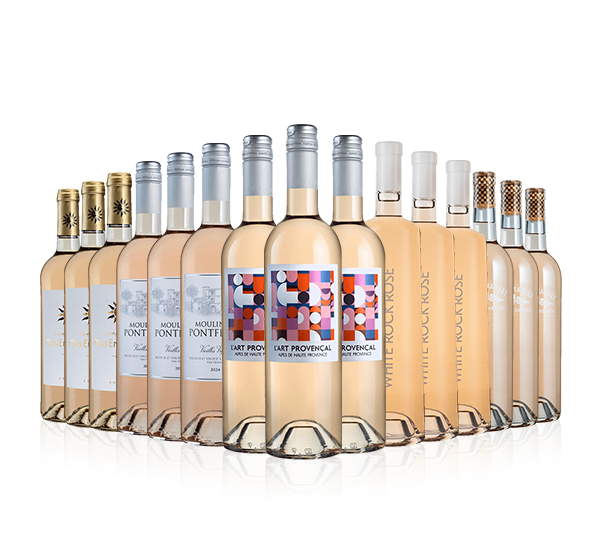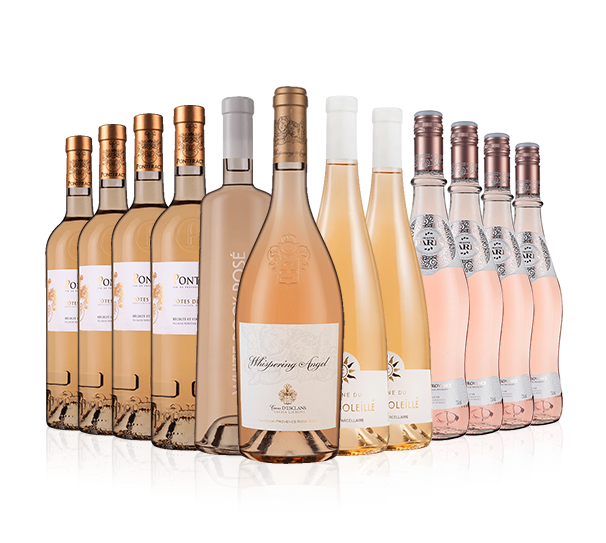Filter by
- Racy-fresh, wild-herb-scented pale pink rosé from the high Alpine foothills of Provence£9.49 per bottleSAVE £4.50
- Bright berry Cabalié rosé from old-vine Grenache and Syrah grapes. Crisp, subtle fruit full of charm£11.99 per bottle
- Single vineyard, super cuvée of Provence pink – such elegance, subtle fruit and crispness£10.99 per bottleSAVE £4.00
- Ripe, fruity with a hint of sweetness, this delightful Californian rosé is a real charmer£7.49 per bottleSAVE £2.50
- Great value and exuberantly fresh rosé, not from Provence but from a top Romanian winery£7.99 per bottle
- As pink and seductive as an Adriatic sunset, this is a delicious, fruit-filled rosato from Abruzzo£8.99 per bottle
- Elegant, berry-fruit pink with delightful freshness from France’s top spot for rosé, Provence£10.99 per bottle
- Rosé you can pour with confidence ... just £7.99 a bottle£119.85 per caseSAVE £13.00
- Everyone’s favourite grape, refreshing Pinot Grigio, done the classic Lake Garda way – in pink!£10.99 per bottle
- Stock up on Provence rosé, the most in-demand pink on the planet£164.85 per caseSAVE £28.00
- From the talented team behind our bestselling Gooseberry Bush comes this raspberry-fresh rosé£9.99 per bottle
- We brought you Black Duck, then White. Now meet the new Pink - crisp, citrusy and cherry ripe£9.99 per bottle
- Racy-fresh Provençal pink with a shimmering streak of minerality that keeps you coming back for more£12.49 per bottle
- A radiant, crisp rosé – vibrant fruit flavours from SW France, made from the rare Négrette grape£9.99 per bottle
- A pale, berry-fresh rosé from a fourth-generation family estate close to Bandol, in Provence£9.99 per bottle
- Whispering Angel and other Provence luxuries plus FREE bottle worth £18.99£161.88 per caseSAVE £36.26
- Enjoy the fresh, ripe fruit of this juicy South African rosé made from Cape hero Pinotage£10.99 per bottle
- Classy, Provençal estate rosé. Dry and subtle, with delicate berry fruit and zesty freshness£13.99 per bottleSAVE £2.00
- Classic Provençal elegance in this rosé by Monsieur Paul, master of pinks of brightness and charm£11.99 per bottle
- A light and fruity Sicilian rosato made from Lucido, plus a drop of Pinot Grigio for a zesty finish£8.49 per bottle
- Classic Provençal elegance in this rosé by Monsieur Paul, master of pinks of brightness and charm£11.99 per bottle
- Exquisite, pale-hued, herbal-scented Provence rosé, using the very pick of the harvest’s grapes£15.99 per bottleSAVE £3.00
- Effortlessly elegant Provençal rosé from an award-winning winery – floral with a lovely freshness£13.99 per bottle
- From a beautiful Cru Classé family estate in the Côtes de Provence, an elegant, crisp rosé£18.99 per bottle
How is rosé wine made?
Rosé wine is commonly made in a similar way to red wine. Once the grapes have been pressed and the clear juice collected, the grape skins are added to the liquid so they can soak and add colour.
The Maceration method is the most common method of making rosé and involves leaving the red grape skins in contact with the grape juice for a brief period during the fermentation process to extract colour. Once the desired colour is obtained, the skins are removed.
The length of time they soak affects the wine’s colour – the longer the grape skins soak, the darker the shade of pink the wine will be. Vin Gris (known as ‘grey wine’ in French) are rosés produced using a very brief maceration – the grape skins barely sit in the juice. This results in a very light-bodied, very pale rosé wine.
Another method of making rosé wine is the saignée method. This involves ‘bleeding off’ some red wine juice during the maceration of red wine. The result is a more concentrated, darker rosé – and saignée rosés are generally characterised by their rich, often intense fruit and punchier savoury flavours. Finally, an alternative is the blending method which sees red and white wines blended together. This is used when blending some sparkling rosés and modern styles such as Sauvignon Blanc rosé.
What are the types and styles of rosé wine?
The variety of methods, regions and grape varieties used in the production of rosé wines gives them a diverse range of styles and characteristics. Rosé wines range from bone dry to moderately sweet, depending on the grapes used and how they are made. While pale pink rosés tend to be drier in style and darker rosés are typically sweeter and fruiter, colour alone can’t determine the sweetness level in your wine.
Here are some of the most common rosé styles to look out for:
- Cabernet Sauvignon Rosé: This is a deep red rosé with flavours similar to red wine. It’s more acidic than regular Cabernet Sauvignon, so look out for notes of blackcurrant, spice and bell pepper.
- Grenache / Garnacha rosé: The most commonly associated grape variety with producing rosé wines is Grenache (known as Garnacha in Spain). Grenache rosé ranges from light and refreshing to full-bodied and rich, but most are dry in style with fresh fruit flavours.
- Mourvèdre Rosé: A full-bodied rosé that packs some intense floral aromas, transforming on the palate into rich cherry and bramble flavours with hints of vanilla and even leather.
- Pinot Noir Rosé: A delicate, crisp rosé with flavours of apple, strawberry and melon. Pinot Noir rosé is commonly produced in California, particularly Napa Valley.
- Provence Rosé: Provençal rosés are renowned for their light-bodied, dry nature and the subtle notes of strawberry, rose petal and green herbs. Many are crafted using a mix of regional grapes like Grenache, Mourvèdre, Shiraz and Cinsault.
- Sangiovese rosé: An Italian wine, this rosé is fruity but dry. Expect notes of fresh strawberries, green melon and roses with a refreshing, acidic finish.
- Shiraz Rosé: A bold, dry wine that’s full of rich flavour with notes of cherry and white pepper. It does not need to be served as cold as most rosé wines.
- Tavel Rosé: Rosé wines from Tavel in the Rhône region of France are robust, savoury, rich and typically very dry. Made from a blend of Grenache, Shiraz and Cinsault, they offer distinct flavours of redcurrant, cassis, cranberries and spice.
- Tempranillo Rosé: A dry and savoury Spanish rosé, with a fruity and hearty flavour profile including cherry, citrus and peppercorn.
- White Zinfandel: A sweeter style of rosé with origins in California. Made using Zinfandel grapes, this blush-coloured wine has flavours of lemon, melon and strawberry.
How do I serve rosé wine?
Chill your rosé wine to bring out its fruity and floral notes – aim for around 10-15°C. Pop it in the fridge a few hours before you want to drink it. Serve your rosé in medium-sized glass and a long stem. The stem keeps your hand from warming the wine, and the bowl makes the flavours and scents pop more when you’re sipping. Cheers!
How long does rosé wine last after opening?
If properly sealed and stored in the fridge after opening, rosé wines can last between three to five days before their juicy flavours begin to dull and turn bitterly acidic, giving you plenty of time to enjoy the rest of the bottle.
What foods pair best with rosé?
While perfect as an aperitif, rosé wine works wonderfully with an array of dishes. Light and dry rosés such as those from Provence and Pinot Noir-based rosés are great with light salads light pasta and rice dishes, grilled fish and goats’ cheeses. Sweeter rosés such as Grenache rosé wines can hold up to slightly spicy foods, making them a good match for Asian cuisine, and barbecue dishes. With fuller, bolder rosé wine, think pizza, grilled chicken and pork dishes.































